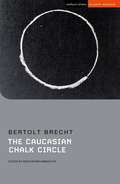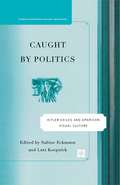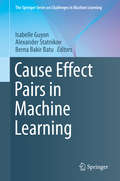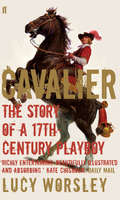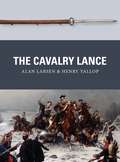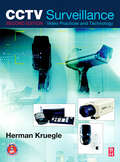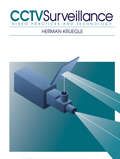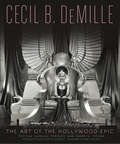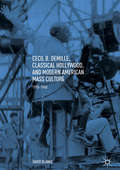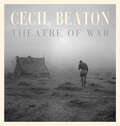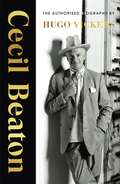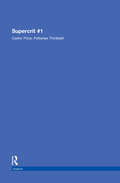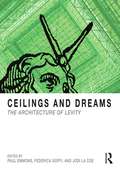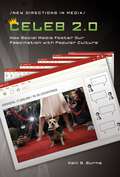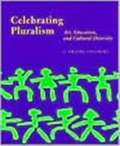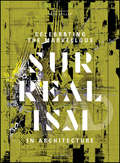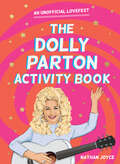- Table View
- List View
The Caucasian Chalk Circle (Student Editions)
by Bertolt BrechtBrecht projects an ancient Chinese story onto a realistic setting in Soviet Georgia. In a theme that echoes the Judgment of Solomon, two women argue over the possession of a child. Thanks to the unruly judge, Azdak (one of Brecht's most vivid creations) natural justice is done and the peasant Grusha keeps the child she loves, even though she is not its mother.Written while Brecht was in exile in the United States during the Second World War, The Caucasian Chalk Circle is a politically charged, much-revived and complex example of Brecht's epic theatre.This new Student Edition contains introductory commentary and notes by Kristopher Imbriggota from the University of Puget Sound, US, offering a much-needed contemporary perspective on the play. The introduction covers:- narrative structure: play about a play within a play ("circle")- songs and music- justice and social systems- context: Brecht, exile, WWII, socialism- notions of collective and class- fable and story adaptation, folk fairy tale
Caught By Politics: Hitler Exiles and American Visual Culture (Studies in European Culture and History)
This book explores German and European exile visual artists, designers and film practitioners in the United States such as Max Beckmann, George Grosz, Hans Richter, Peter Lorre, and Edgar Ulmer and examines how American artists including Walter Quirt, Jackson Pollock, and Robert Motherwell responded to the Europeanization of American culture.
Cause Effect Pairs in Machine Learning (The Springer Series on Challenges in Machine Learning)
by Isabelle Guyon Alexander Statnikov Berna Bakir BatuThis book presents ground-breaking advances in the domain of causal structure learning. The problem of distinguishing cause from effect (“Does altitude cause a change in atmospheric pressure, or vice versa?”) is here cast as a binary classification problem, to be tackled by machine learning algorithms. Based on the results of the ChaLearn Cause-Effect Pairs Challenge, this book reveals that the joint distribution of two variables can be scrutinized by machine learning algorithms to reveal the possible existence of a “causal mechanism”, in the sense that the values of one variable may have been generated from the values of the other. This book provides both tutorial material on the state-of-the-art on cause-effect pairs and exposes the reader to more advanced material, with a collection of selected papers. Supplemental material includes videos, slides, and code which can be found on the workshop website.Discovering causal relationships from observational data will become increasingly important in data science with the increasing amount of available data, as a means of detecting potential triggers in epidemiology, social sciences, economy, biology, medicine, and other sciences.
Cavalier: The Story Of A 17th Century Playboy
by Lucy WorsleyWilliam Cavendish, courageous, cultured and passionate about women, embodies the popular image of a cavalier. Famously defeated at the Battle of Marston Moor in 1644, he went into a long and miserable continental exile before returning to England in triumph on the restoration of King Charles II to the throne in 1660.Lucy Worsley brings to life a fascinating household of the 17th century, painting a picture of conspiracy, sexual intrigue, clandestine marriage and gossip. From Ben Jonson and Van Dyck to a savage, knife-wielding master-cook, Cavalier is a brilliant illumination of the stately home in England and all its many colourful inhabitants.
The Cavalry Lance (Weapon)
by Peter Dennis Alan Larsen Henry YallopThe development of cavalry firearms and the widespread disappearance of armour from the European battlefield saw a decline in the use of the cavalry lance in early modern warfare. However, by 1800 the lance, much changed from its medieval predecessors in both form and function, was back.During the next century the use of the lance spread to the armed forces of almost every Western country, seeing action in every major conflict from the Napoleonic Wars to World War I including the Crimean and Franco-Prussian wars and across the Atlantic in the American Civil War. The lance even reached the colonial conflicts of the Anglo-Sikh and Boer wars. It was not until the disappearance of the mounted warrior from the battlefield that the lance was consigned to history.Featuring specially commissioned artwork and drawing upon a variety of sources, this is the engaging story of the cavalry lance at war during the 19th and 20th centuries, from Waterloo to the Somme.
The Cavalry Lance (Weapon #59)
by Peter Dennis Alan Larsen Henry YallopThe development of cavalry firearms and the widespread disappearance of armour from the European battlefield saw a decline in the use of the cavalry lance in early modern warfare. However, by 1800 the lance, much changed from its medieval predecessors in both form and function, was back.During the next century the use of the lance spread to the armed forces of almost every Western country, seeing action in every major conflict from the Napoleonic Wars to World War I including the Crimean and Franco-Prussian wars and across the Atlantic in the American Civil War. The lance even reached the colonial conflicts of the Anglo-Sikh and Boer wars. It was not until the disappearance of the mounted warrior from the battlefield that the lance was consigned to history.Featuring specially commissioned artwork and drawing upon a variety of sources, this is the engaging story of the cavalry lance at war during the 19th and 20th centuries, from Waterloo to the Somme.
CCTV Surveillance: Video Practices and Technology
by Herman KruegleThis revision of the classic book on CCTV technology, CCTV Surveillance, provides a comprehensive examination of CCTV, covering the applications of various systems, how to design and install a system, and how to choose the right hardware. Taking into account the ever-changing advances in technology using digital techniques and the Internet, CCTV Surveillance, Second Edition, is completely updated with the recent advancements in digital cameras and digital recorders, remote monitoring via the Internet, and CCTV integration with other security systems. Continuing in the celebrated tradition of the first edition, the second edition is written to serve as a useful resource for the end-user as well as the technical practitioner. Each chapter begins with an overview, and presents the latest information on the relevant equipment, describing the characteristics, features and application of each device. Coverage of aging or obsolete technology is reduced to a historical perspective, and eight brand new chapters cover digital video technology, multiplexers, integrated camera-lens-housing, smart domes, and rapid deployment CCTV systems.Serves as an indispensable resource on CCTV theoryIncludes eight new chapters on the use of digital components and other related technologies that have seen a recent explosion in use Fully illustrated, the book contains completely updated photographs and diagrams that represent the latest in CCTV technology advancements
CCTV Surveillance: Video Practices and Technology
by Author UnknownA complete reference on CCTV technology Gives practical advice on the proper uses of CCTV to best protect against crime Contains more than 100 photos of the most modern equipment available.
CDM 2015: A Practical Guide for Architects and Designers
by Paul BusseyThis is the designer’s essential guide to implementing the new CDM 2015 regulations. It provides both a straightforward overview of the key changes and new duty holders, including the Principal Designer, as well as full colour diagrams and annotated plans which demonstrate how to apply the principles in the real world. As the regulations come into force it aims to reassure those fearing a change in their obligations by outlining easy to use practical tools which will integrate the philosophy of the new regulations – of proportionate response, creative solutions and collaborative working – into day-to-day practice. It’s designed as a concise and handy quick reference guide, easy to carry around on site or use at your desk, translating what can be dry and often impenetrable legislation into a set of simple, intuitive, design friendly and safe messages.
CDM 2015: A Practical Guide for Architects and Designers
by Paul BusseyThis is the designer’s essential guide to implementing the new CDM 2015 regulations. It provides both a straightforward overview of the key changes and new duty holders, including the Principal Designer, as well as full colour diagrams and annotated plans which demonstrate how to apply the principles in the real world. As the regulations come into force it aims to reassure those fearing a change in their obligations by outlining easy to use practical tools which will integrate the philosophy of the new regulations – of proportionate response, creative solutions and collaborative working – into day-to-day practice. It’s designed as a concise and handy quick reference guide, easy to carry around on site or use at your desk, translating what can be dry and often impenetrable legislation into a set of simple, intuitive, design friendly and safe messages.
CDOs in the Public Sector: Perspectives on Chief Digital Officers and Digital Transformation Strategies (SpringerBriefs in Applied Sciences and Technology)
by Christian SchachtnerThis book explores the need for innovative approaches to administrative digitization, leveraging technologies such as AI, blockchain, and smart processes to meet citizens' expectations, with a particular focus on the role of Chief Digital Officers (CDOs) in driving successful digital transformations within public institutions. Administrative digitization requires fresh inputs to match the leaps seen in the industry sector, utilizing technologies like AI-driven automation, blockchain transactions, and security tools. Smart process solutions are seen as transformative in upholding service standards aligned with citizens' state expectations. Unlike commercial companies, collaboration offers those overseeing public sector digitization enhanced scaling opportunities by drawing from experiences in other regions and metropolises, directly applicable and reusable. In the public realm, digital strategies mirror legal and social conditions, necessitating adjustments and adaptation options for Chief Digital Officers as they lead digital transformation. Methodological focal points in task structure redesign, process optimization, and motivating actors yield diverse action areas for the CDO's new role in public institutions. This book explores the instruments, strategies, and attitudes necessary to successfully implement transformative initiatives in organizations, emphasizing proven concepts with practical applicability, enabling readers to derive their own interaction options as digital guidance leaders. The book is a concise introduction to the specific requirements for visionary designers driving dynamic changes in user-centric public services.
Cecil B. DeMille: The Art of the Hollywood Epic
by Cecilia de Mille Presley Mark A. VieiraColossal. Stupendous. Epic. These adjectives, used by movie companies to hawk their wares, became clichés long ago. When used to describe the films of one director, they are accurate. More than any filmmaker in the history of the medium, Cecil B. DeMille mastered the art of the spectacle. In the process, he became a filmland founder. One hundred years ago, he made the first feature film ever shot in Hollywood and went on to become the most commercially successful producer-director in history.DeMille told his cinematic tales with painterly, extravagant images. The parting of the Red Sea in The Ten Commandments was only one of these. There were train wrecks (The Greatest Show on Earth); orgies (Manslaughter); battles (The Buccaneer); Ancient Rome (The Sign of the Cross); Ancient Egypt (Cleopatra); and the Holy Land (The Crusades). The best of these images are showcased here, in Cecil B. DeMille: The Art of the Hollywood Epic.This lavish volume opens the King Tut's tomb of cinematic treasures that is the Cecil B. DeMille Archives, presenting storyboard art, concept paintings, and an array of photographic imagery. Historian Mark A. Vieira writes an illuminating text to accompany these scenes. Cecilia de Mille Presley relates her grandfather's thoughts on his various films, and recalls her visits to his sets, including the Egyptian expedition to film The Ten Commandments.Like the director's works, Cecil B. DeMille: The Art of the Hollywood Epic is a panorama of magnificence-celebrating a legendary filmmaker and the remarkable history of Hollywood.
Cecil B. DeMille: The Art of the Hollywood Epic
by Cecilia de Mille Presley Mark A. VieiraColossal. Stupendous. Epic. These adjectives, used by movie companies to hawk their wares, became clichélong ago. When used to describe the films of one director, they are accurate. More than any filmmaker in the history of the medium, Cecil B. DeMille mastered the art of the spectacle. In the process, he became a filmland founder. One hundred years ago, he made the first feature film ever shot in Hollywood and went on to become the most commercially successful producer-director in history. DeMille told his cinematic tales with painterly, extravagant images. The parting of the Red Sea in The Ten Commandments was only one of these. There were train wrecks (The Greatest Show on Earth); orgies (Manslaughter); battles (The Buccaneer); Ancient Rome (The Sign of the Cross); Ancient Egypt (Cleopatra); and the Holy Land (The Crusades). The best of these images are showcased here, in Cecil B. DeMille: The Art of the Hollywood Epic. This lavish volume opens the King Tut's tomb of cinematic treasures that is the Cecil B. DeMille Archives, presenting storyboard art, concept paintings, and an array of photographic imagery. Historian Mark A. Vieira writes an illuminating text to accompany these scenes. Cecilia de Mille Presley relates her grandfather's thoughts on his various films, and recalls her visits to his sets, including the Egyptian expedition to film The Ten Commandments. Like the director's works, Cecil B. DeMille: The Art of the Hollywood Epic is a panorama of magnificence-celebrating a legendary filmmaker and the remarkable history of Hollywood.
Cecil B. DeMille, Classical Hollywood, and Modern American Mass Culture: 1910-1960
by David BlankeThis book uses the long and profitable career of Cecil B. DeMille to track the evolution of Classical Hollywood and its influence on emerging mass commercial culture in the US. DeMille’s success rested on how well his films presumed a broad consensus in the American public—expressed through consumer hedonism, faith, and an “exceptional” national history—which merged seamlessly with the efficient production methods developed by the largest integrated studios. DeMille’s sudden mid-career shift away from spectator perversity to corporate propagandist permanently tarnished the director’s historical standing among scholars, yet should not overshadow the profound links between his success and the rise and fall of mid-century mass culture.
Cecil Beaton: Theatre Of War
by Cecil BeatonAt the beginning of the Second World War the Ministry of Information, through the advice of Kenneth Clark, commissioned Cecil Beaton to photograph the Home Front. Beaton set to work recording the destruction of the Wren churches in the City and the heroism of Londoners under attack. He conducted a survey of Bomber and Fighter Commands for the RAF, which was published with Beaton's own astute commentary. Beaton was an effective propagandist, but his voice, like his photographs, was touchingly elegant. Whatever his subject, Beaton was always a stylist.Beaton's wartime work for the Ministry amounted to seven thousand photographs, which are now housed with their negatives at the Imperial War Museums. They form a great document both of the landscape of war and of the passing of the Empire. He travelled through the Western Desert and on to Iraq, Palestine, Transjordan and Syria. In 1943 he left for India where he photographed the final days of the Raj in New Delhi and Calcutta before joining the Burma campaign. He ended the war deep in Chinese territory where he witnessed the Nationalist resistance to the Japanese. Beaton's inherent sense of theatre extended from palatial drawing rooms to the jungle and the desert. Whatever the circumstances he never departed from his radical aesthetic. Theatre of War is published in conjunction with the Imperial War Museums on the occasion of a major exhibition.
Cecil Beaton: The Authorised Biography (Phoenix Press Ser.)
by Hugo VickersCecil Beaton was one of Britain's greatest cultural icons - not just as a photographer capturing some of the most celebrated portraits of the 20th century but also as designer of the iconic sets and costumes for the films My Fair Lady and Gigi. In 1980, Beaton personally chose Hugo Vickers to be his biographer, entrusting him with his diaries and the entire body of letters he had written - both personally and professionally - over the course of his life. Drawing on five years of intensive research and interviews with the likes of Audrey Hepburn, Truman Capote, Princess Grace of Monaco and Sir John Gielgud, Vickers' biography was an instant bestseller upon its publication in 1985. Exploring Beaton's metamorphosis from being the child of a staid middle-class family to an international figure mingling with the glittering stars of his age, the biography also details his great love for Greta Garbo and reveals his private sense of failure that the success he always wanted - as a playwright - eluded him. Republished in a new paperback edition in time for Bright Young Things, a major exhibition at the National Portrait Gallery in 2020, Cecil Beaton is the definitive and authorised biography of one of the world's most fascinating, famous and admired photographers.
Cedric Price: SuperCrit #1
The Supercrit series revisits some of the most influential architectural projects of the recent past and examines their impact on the way we think and design today. Based on live studio debates between protagonists and critics, the books describe, explore and criticise these major projects. This first book in the unprecedented series examines Cedric Price’s groundbreaking Potteries Thinkbelt project from the 1960s, an innovative high-tech educational facility in the North Staffordshire Potteries. Highly illustrated and with contemporary criticism, this is a book not to be missed!In Cedric Price: Potteries Thinkbelt you can hear the architect’s project definition, see the drawings and join in the crit. This innovative and compelling book is an invaluable resource for any architecture student.
Cedric Price: SuperCrit #1
The Supercrit series revisits some of the most influential architectural projects of the recent past and examines their impact on the way we think and design today. Based on live studio debates between protagonists and critics, the books describe, explore and criticise these major projects. This first book in the unprecedented series examines Cedric Price’s groundbreaking Potteries Thinkbelt project from the 1960s, an innovative high-tech educational facility in the North Staffordshire Potteries. Highly illustrated and with contemporary criticism, this is a book not to be missed!In Cedric Price: Potteries Thinkbelt you can hear the architect’s project definition, see the drawings and join in the crit. This innovative and compelling book is an invaluable resource for any architecture student.
Ceilings and Dreams: The Architecture of Levity
by Paul Emmons Federica Goffi Jodi La CoeWhere is the space for dreaming in the twenty-first century? Lofty thoughts, like dreams, are born and live overhead, just as they have been represented in Renaissance paintings and modern cartoons. Ceilings are often repositories of stories, events and otherwise invisible oneiric narratives. Yet environments that inspire innovative thinking are dwindling as our world confronts enormous challenges, and almost all of our thinking, debating and decision-making takes place under endless ceiling grids. Quantitative research establishes that spaces with taller ceilings elicit broader, more creative thoughts. Today, ceilings are usually squat conduits of technology: they have become the blind spot of modern architecture. The twenty essays in this book look across cultures, places and ceilings over time to discover their potential to uplift the human spirit. Not just one building element among many, the ceiling is a key to unlock the architectural imagination. Ceilings and Dreams aims to correct this blind spot and encourages architects and designers, researchers and students, to look up through writings organized into three expansive categories: reveries, suspensions and inversions. The contributors contemplate the architecture of levity and the potential of the ceiling, once again, as a place for dreaming.
Ceilings and Dreams: The Architecture of Levity
by Paul Emmons Federica Goffi Jodi La CoeWhere is the space for dreaming in the twenty-first century? Lofty thoughts, like dreams, are born and live overhead, just as they have been represented in Renaissance paintings and modern cartoons. Ceilings are often repositories of stories, events and otherwise invisible oneiric narratives. Yet environments that inspire innovative thinking are dwindling as our world confronts enormous challenges, and almost all of our thinking, debating and decision-making takes place under endless ceiling grids. Quantitative research establishes that spaces with taller ceilings elicit broader, more creative thoughts. Today, ceilings are usually squat conduits of technology: they have become the blind spot of modern architecture. The twenty essays in this book look across cultures, places and ceilings over time to discover their potential to uplift the human spirit. Not just one building element among many, the ceiling is a key to unlock the architectural imagination. Ceilings and Dreams aims to correct this blind spot and encourages architects and designers, researchers and students, to look up through writings organized into three expansive categories: reveries, suspensions and inversions. The contributors contemplate the architecture of levity and the potential of the ceiling, once again, as a place for dreaming.
Celeb 2.0: How Social Media Foster Our Fascination with Popular Culture (New Directions in Media)
by Kelli S. BurnsThis volume looks at how the new capabilities of Web 2.0 are changing the worlds of celebrity fandom and gossip.With Ashton Kutcher's record-breaking "tweeting" more famous than his films, and Perez Hilton actually getting more attention than Paris, the actress often covered in his blog, the worlds of celebrity celebration and online social networking are pushing the public's crush on the famous and infamous into overdrive. Celeb 2.0: How Social Media Foster Our Fascination with Popular Culture explores this phenomenon.Celeb 2.0 looks at how blogs, video sharing sites, user-news sites, social networks, and message boards are fueling America's already voracious consumption of pop culture. Full of fascinating insights and interviews, the book looks at how celebrities use blogs, Twitter, and other tools, how YouTube and other sites create celebrity, how Web 2.0 shortens the distance between fans and stars, and how the new social media influences news reporting and series television.
Celeb 2.0: How Social Media Foster Our Fascination with Popular Culture (New Directions in Media)
by Kelli S. BurnsThis volume looks at how the new capabilities of Web 2.0 are changing the worlds of celebrity fandom and gossip.With Ashton Kutcher's record-breaking "tweeting" more famous than his films, and Perez Hilton actually getting more attention than Paris, the actress often covered in his blog, the worlds of celebrity celebration and online social networking are pushing the public's crush on the famous and infamous into overdrive. Celeb 2.0: How Social Media Foster Our Fascination with Popular Culture explores this phenomenon.Celeb 2.0 looks at how blogs, video sharing sites, user-news sites, social networks, and message boards are fueling America's already voracious consumption of pop culture. Full of fascinating insights and interviews, the book looks at how celebrities use blogs, Twitter, and other tools, how YouTube and other sites create celebrity, how Web 2.0 shortens the distance between fans and stars, and how the new social media influences news reporting and series television.
Celebrating Pluralism: Art, Education, and Cultural Diversity (PDF) (Occasional Paper Ser. #Vol. 5)
by F. Graeme Chalmers"Educational trends will change and research agendas will shift, but art teachers in public institutions will still need to educate all students for multicultural purposes," argues Chalmers in this fifth volume in the Occasional Papers series. Chalmers describes how art education programs promote cross-cultural understanding, recognize racial and cultural diversity, enhance self-esteem in students' cultural heritage, and address issues of ethnocentrism, stereotyping, discrimination, and racism. After providing the context for multicultural art education, Chalmers examines the implications for art education of the broad themes found in art across cultures. Using discipline-based art education as a framework, he suggests ways to design and implement a curriculum for multicultural art education that will help students find a place for art in their lives. Art educators will find Celebrating Pluralism invaluable in negotiating the approach to multicultural art education that makes the most sense to their students and their communities.
Celebrating the Marvellous: Surrealism in Architecture (Architectural Design)
by Neil SpillerWe are entering a new era of architecture that is technologically enhanced, virtual and synthetic. Contemporary architects operate in a creative environment that is both real and digital; mixed, augmented and hybridised. This world consists of ecstasies, fears, fetishisms and phantoms, processes and spatiality that can best be described as Surrealist. Though too long dormant, Surrealism has been a significant cultural force in modern architecture. Founded by poet André Breton in Paris in 1924 as an artistic, intellectual and literary movement, architects such as Le Corbusier, Diller + Scofidio, Bernard Tschumi and John Hejduk realised its evocative powers to propel them to 'starchitect' status. Rem Koolhaas most famously illustrated Delirious New York (1978) with Madelon Vriesendorp's compelling Surrealist images. Architects are now reviving the power of Surrealism to inspire and explore the ramifications of advanced technology. Architects' studios in practices and schools are becoming places where nothing is forbidden. Architectural languages and theories are 'mashed' together, approaches are permissively appropriated, and styles are not mutually exclusive. Projects are polemic, postmodern and surreally media savvy. Today's architects must compose space that operates across the spatial spectrum. Surrealism, with its multiple readings of the city, its collage semiotics, its extruded forms and artificial landscapes, is an ideal source for contemporary architectural inspiration. Contributors include: Bryan Cantley, Nic Clear, James Eagle, Natalie Gall, Mark Morris, Dagmar Motycka Weston, Alberto Perez-Gomez, Shaun Murray, Anthony Vidler, and Elizabeth Anne Williams. Featured architects: Nigel Coates, Hernan Diaz Alonso, Perry Kulper, and Mark West.
A Celebration of Dolly Parton: The Activity Book
by Nathan JoyceRecognising one of the most-honoured performers of all time, A Celebration of Dolly Parton: The Activity Book is 2021’s follow-up to A Celebration of David Attenborough: The Activity Book and The Unofficial Michelle Obama Activity Book.
